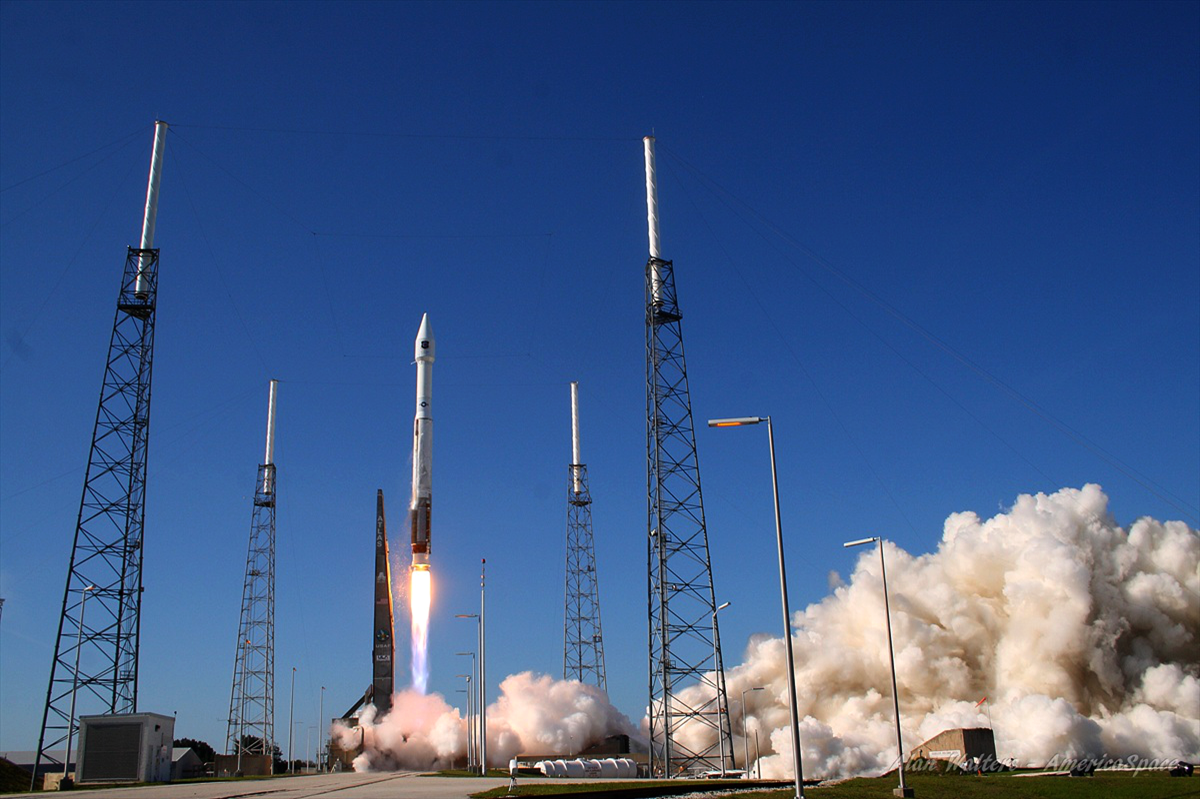
Between them, they have spent nearly five decades sending robotic explorers to almost every planet—and a few “non-planets,” too—in our Solar System. Missions bound for Mars, Jupiter, Saturn, Uranus, Neptune, and Pluto have set off from the cradling arms and expansive flame trenches of their enormous gantries. Other missions bound for low, medium, and geosynchronous Earth orbits have similarly soared on lofty voyages of exploration and discovery or upon more discreet intelligence-gathering and surveillance operations. Space Launch Complexes (SLC)-40 and 41, situated at the north end of Cape Canaveral Air Force Station, Fla., have staged more than a hundred launches between them since 1965. Even as we head toward the middle of the second decade of the 21st century, they show no sign of slowing down and their futures hold great promise.
At the time of writing, SLC-41 is within days of reverberating to the exhaust of its next rocket client. On 19 July, United Launch Alliance’s Atlas V—flying in its most powerful current configuration, the “551,” with a large payload fairing, five strap-on solid-fueled boosters, and a single-engine Centaur upper stage—will roar away from the pad on a mission to deliver the 15,000-pound Mobile User Objective System (MUOS)-2 satellite into geosynchronous orbit for the Pentagon. Only three other Atlas V missions have flown in this high-powered configuration and all have done so from SLC-41. In January 2006, New Horizons blazed onto an Earth-and-solar-escape trajectory to reach the dwarf planet Pluto and the mysterious Kuiper Belt, after which the Juno polar orbiter was boosted toward Jupiter in August 2011. Most recently, the heavyweight MUOS-1 lifted off in February 2012. SLC-41’s staging of the New Horizons mission enabled the spacecraft to depart Earth at more than 36,300 mph, the greatest-ever launch speed for a man-made object.
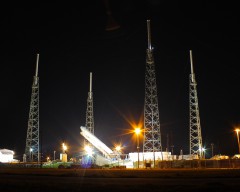
History-making is a suitable descriptor for SLC-41 and its sister complex, SLC-40, whose own current portfolio of operations is focused on SpaceX and its Falcon 9 vehicle. Ever since Elon Musk’s Hawthorne, Calif.-based aerospace company officially broke ground at SLC-40, back in November 2007, the complex has seen a new lease of commercial life as the principal staging post for Dragon cargo missions under the $1.9 billion Commercial Resupply Services (CRS) contract with NASA. Yet for decades before SpaceX was even created, both complexes supported missions which have literally transformed our perception of our own planet and our place in the cosmos. In September 1992, Mars Observer—though ultimately unsuccessful in its effort to reach and explore the Red Planet—was launched from SLC-40. It marked the United States’ first foray to Mars in almost two decades, and the seed was sown for subsequent missions: the Mars Reconnaissance Orbiter (MRO) and the Mars Science Laboratory (MSL)—including NASA’s Curiosity rover—were both launched from SLC-41 in August 2005 and November 2011 respectively.
Complexes 40 and 41 originated in the heyday of the “Space Race,” back in the early 1960s, as part of the $39 million “Integrate-Transfer-Launch” (ITL) facility for the U.S. Air Force’s Titan rocket family. The first launch from Complex 40 was a vehicle test of the Titan IIIC on 18 June 1965, which boosted a lead-ballast “trans-stage” into a low orbit. Six months later, on 21 December, another Titan IIIC roared aloft from Complex 41 with satellites to explore the magnetosphere, demonstrate new communications technologies, and support amateur radio applications.
Those launches opened the floodgates for dozens of missions which were to follow. Although SLC-40 is today utilized by SpaceX’s Falcon 9—and has supported five launches between June 2010 and March 2013, including three Dragon cargo deliveries to the International Space Station—its heritage has been predominantly military. In the aftermath of its first launch in June 1965, it hosted the Titan IIIC for more than two decades, transporting a myriad of classified payloads into orbit: Defense Support Program (DSP) early-warning sentinels, Defense Satellite Communications System (DSCS) military communications satellites, and a series of naval signals reconnaissance platforms. From February 1994, SLC-40 supported the Titan IV rocket and was utilized to boost Milstar military communications satellites and “Advanced Orion” signals intelligence satellites into orbit. In April 2005, the final Titan IV flew from the complex, carrying the Lacross-5 radar-imaging and surveillance sentinel into orbit.
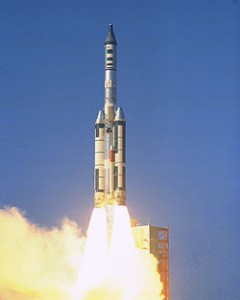
One significant military mission of note took place in November 1966. On only its third launch, a Titan IIIC speared aloft from Complex 40 … carrying a modified Titan II propellant tank, which had been outfitted as a mockup of the U.S. Air Force’s Manned Orbital Laboratory (MOL). Atop the modified tank was the refurbished Gemini 2 spacecraft—which had originally flown from Cape Canaveral’s Pad 19 in January 1965—and the mission sought to test the MOL/Gemini combination. As planned, the Gemini spacecraft was jettisoned late in the ascent and performed a nominal re-entry and splashdown in the Atlantic Ocean. In so doing, it settled one of the program’s critical worries: that the MOL access hatch, cut into the Gemini’s base heat shield, could seal shut during the inferno of re-entry. Alas, the success of the MOL/Gemini demo carried little promise for MOL itself, which was cancelled by President Richard Nixon in June 1969.
Civilian programs have also shared SLC-40 over the years. In May 1974, NASA’s Application Technology Satellite (ATS)-6 was launched, beginning a five-year mission to trial experimental communications technologies in geosynchronous orbit. It delivered educational programs to India, the United States, and elsewhere, conducted air traffic control tests, performed satellite-assisted search-and-rescue operations, and pioneered direct-broadcast television. At the time of its launch, ATS-6 was the most powerful telecommunications satellite ever launched and was the first three-axis-stabilized spacecraft to be placed into geosynchronous orbit.
SLC-40 also supported the four launches of Martin Marietta’s short-lived Commercial Titan III. In January 1990, the maiden flight of the new booster carried Britain’s Skynet-4A military communications satellite—originally destined for deployment from the shuttle—and Japan’s JCSat-2. A second Commercial Titan in March placed the Intelsat-603 satellite into a lower-than-planned orbit, leading to discussions with NASA which culminated in a daring shuttle rescue mission in May 1992. Although a third Commercial Titan successfully inserted Intelsat-604 into geosynchronous orbit in June 1990, launches dried up for more than two years as SLC-40 underwent a $425 million renovation project. During this period, the complex was almost completely rebuilt. In September 1992, the final Commercial Titan III carried NASA’s Mars Observer aloft … but less than a year later, shortly prior to injection into orbit around the Red Planet, all contact with the spacecraft was lost.
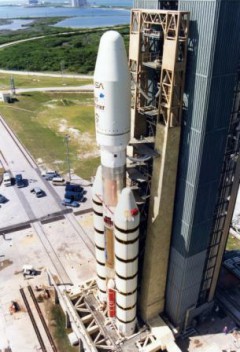
The renovation work was geared toward supporting the Titan IV rocket, which carried its first payload from SLC-40—a Milstar military communications satellite—into orbit in February 1994. The rest of the decade was predictable for the complex, with alternating launches of Milstars and DSP early-warning satellites, with the odd Advanced Orion thrown in … until October 1997, when it played host to NASA’s Cassini mission and Europe’s piggyback Huygens probe. Launched by Titan IV, the mission began a seven-year journey to Saturn and became the first craft to enter orbit around the mysterious ringed planet. Early in 2005, Huygens entered the atmosphere of Saturn’s largest moon, Titan, and successfully touched down on its surface. The Cassini mission remains operational until 2017 and has revolutionized our understanding of the Saturnian system.
Of course, there have been a handful of failures along the way. The second Titan IIIC to depart Complex 40, back in October 1965, suffered the disintegration of its upper stage during ascent, whilst the launch of a naval signals intelligence satellite in September 1988 went similarly awry. In addition to the problematic flight of Intelsat-603, a Titan IV dumped a Milstar satellite into an unusable orbit in April 1999. Since then, SLC-40 has seen a run of successful missions. In the wake of its final Titan IV flight in the spring of 2005, the process of disassembly began and in April 2007 the U.S. Air Force Space Command granted permission for SpaceX to take over the site for its Falcon rockets. A year later, in April 2008, the old complex was demolished in a controlled explosion to prepare for the construction of Falcon-specific facilities. “Much of the pad complex will still be usable by SpaceX,” it was noted at the time. “The concrete deck and flame duct, the water deluge system, the site’s electrical system, the lightning towers, and the instrumentation bay beneath the pad will all be reused.” New liquid oxygen and kerosene tankage for SpaceX’s Falcon rockets was subsequently installed, together with the construction of an integration hangar.
In June 2010, after a five-year hiatus, SLC-40 echoed to the roar of rocket engines once again, as a Falcon 9 flew its maiden voyage with a qualification unit of the Dragon cargo ship. Six months later, a second launch successfully completed the Commercial Orbital Transportation Services (COTS) Demo Flight-1, sending Dragon on a three-hour, two-orbit mission, which concluded with a perfect, parachute-assisted splashdown in the Pacific Ocean. Eighteen months later, in May 2012, SpaceX triumphantly delivered its COTS Demo Flight-2 to the International Space Station, delivering equipment and supplies to the resident Expedition 31 crew and marking the first time that a privately-sponsored craft had ever docked at the orbital outpost. Since then, of course, SpaceX has staged the first two missions under its $1.9 billion Commercial Resupply Services (CRS) contract with NASA: two Dragons were launched in October 2012 and March 2013, with a third tentatively scheduled from SLC-40 in late November.
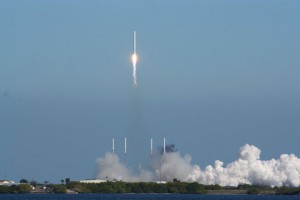
With SLC-40 now firmly transitioned from an almost-exclusive military-use facility to a commercial launch site operated by SpaceX, its sister complex—SLC-41—is now operated by United Launch Alliance (ULA) and has supported 38 flights of the Atlas V vehicle since August 2002. The complex originated at the same time as SLC-40, and its first 12 years of operations included a mixture of military satellites (for communications, nuclear detection, and surveillance) and civilian satellites (for technology, magnetospheric research, and solar science). In February 1974, the uprated Titan IIIE-Centaur failed dismally on its maiden launch, when a liquid oxygen pump malfunctioned in the upper stage. This posed significant ramifications for NASA, which intended to use the Titan IIIE-Centaur for four major deep-space missions: the twin Voyager probes to the outer planets and the twin Viking orbiters and landers to Mars. Fortunately, each of these missions went off without a hitch. The Viking 1 orbiter and lander were launched from SLC-41 in August 1975 and reached Mars the following June, whilst Viking 2 roared aloft in September 1975 and entered orbit around the Red Planet the following August. Both orbiters deployed their landers to touch down on the blood-red surface in one of the grandest endeavors of scientific discovery ever undertaken.
That is, until Project Voyager. And with Project Voyager, the might of SLC-41 was truly demonstrated, as one of its clients traveled further into space than any man-made machine in history. In August 1977, Voyager 2 was launched on a mission whose trajectory guaranteed a rendezvous with Jupiter and Saturn, but which also left open the option to continue to Uranus and Neptune. Its twin, Voyager 1, set off two weeks later, in early September, on a shorter, faster trajectory, which would take it past Jupiter and Saturn. If the Viking missions whetted the public appetite for exploration of Mars, then the odyssey of the Voyagers (which continues to this day, as both probes approach the very edge of the Solar System) confirmed our true place in the cosmos. On St. Valentine’s Day 1990, Voyager 1 took a photograph of six of the planets—Venus, Jupiter, Saturn, Uranus, Neptune, and our own Planet Earth—from a distance of 3.7 billion miles. The profound sight of our world as a blue blob in a fathomless ocean of emptiness prompted cosmologist Carl Sagan to write in his book Pale Blue Dot: “Consider again that dot. That’s here. That’s home. On it, everyone you love, everyone you know, everyone you ever heard of, every human being who ever was … lived out their lives … ”

After the launch of the Voyagers, SLC-41 was deactivated for almost a decade. Then, in 1986, efforts to implement a $57 million refurbishment program got underway, with the eventual aim of launching the U.S. Air Force’s Titan IV from the complex. In June 1989, SLC-41 was back in action as it supported the maiden voyage of the new rocket with a DSP satellite. Subsequent missions were exclusively military in nature: early-warning satellites, naval reconnaissance satellites and signals, and electronic intelligence satellites. By the late 1990s, it was becoming increasingly clear that the Titan IV was enormously expensive to operate and the evolution of modern technology was gradually rendering it obsolete. Its last two flights from SLC-41—in August 1998 and April 1999—both ended in disaster, the first due to a guidance system fault, the second due to a glitch with the Inertial Upper Stage (IUS) separation mechanism.
By now, the Air Force had contracted with Lockheed Martin to develop a new vehicle, the Atlas V, and in October 1999 SLC-41 was demolished with high explosives. Three years later, in August 2002, the first of this new breed of rockets roared skyward with Eutelsat’s Hot Bird-6 communications satellite—a wholly civilian launch from SLC-41 for the first time in more than two decades. Over the next few years, the Atlas V proved its mettle and reliability, delivering communications satellites into orbit and despatching key missions of exploration and discovery: the Mars Reconnaissance Orbiter (MRO) in August 2005, New Horizons in January 2006, the Lunar Reconnaissance Orbiter (LRO) in June 2009, the Solar Dynamics Observatory—part of NASA’s Living With a Star program—in February 2010, the Juno probe to Jupiter in August 2011, the Mars Science Laboratory and Curiosity rover in November 2011, and the Van Allen Probes (formerly the Radiation Belt Storm Probes) in August 2012.
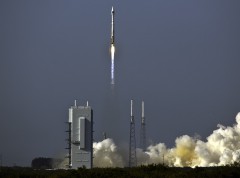
Juxtaposed with these civilian missions were a series of missions to provide operational capability for U.S. military assets. Atlas V boosters flew from SLC-41 to deliver the Air Force’s X-37B Orbital Test Vehicle (OTV) on three missions—the most recent of which began in December 2012—and the first heavyweight Mobile User Objective System (MUOS-1) in February last year. Earlier in 2013, SLC-41 played host to the launch of SBIRS GEO-2, the second Geosynchronous Space-Based Infrared System, and in January NASA’s latest Tracking and Data Relay Satellite (TDRS-K) was also boosted into orbit. Atlas V launches are conducted not only from SLC-41, but also from Vandenberg Air Force Base, Calif., and across the span of more than a decade of operations the vehicles are proving exceptionally reliable.
And what is next for these venerable complexes, SLC-40 and 41? What is known with certainty is that the roar of rocket engines will not cease and will only intensify. After the scheduled 19 July flight of MUOS-2 aboard an Atlas V, many other customers—attracted by the vehicle’s reliability and flexibility—have firmly and provisionally booked their payload places. NASA’s Mars Atmosphere and Volatile Evolution (MAVEN) mission will fly from SLC-41 in November 2013, and it is possible that an Atlas V may also boost the Origins-Spectral Interpretation Resource Identification Security Regolith Explorer (OSIRIS-REx) in September 2016 to collect and return soil samples from the newly-renamed Asteroid Bennu.
As for SLC-40, with Elon Musk and SpaceX in the driver’s seat, the sky—and, perhaps, the sand of Mars—really is the limit. The startup company already has a dozen contracted Dragon cargo delivery missions to perform to the International Space Station by 2016, the third of which is currently scheduled to launch in late November. In addition, SLC-40 will also play host to a pad-abort test of the eight SuperDraco engines of the human-rated Dragon ship, later this year or early in 2014. The test will simulate a Falcon 9 launch anomaly, after which the SuperDraco thrusters will blast the Dragon to an altitude of about 5,000 feet, then parachute it back towards a splashdown in the Atlantic Ocean. The realization of the pad test will serve to cement Musk’s firm commitment to flying NASA astronauts commercially to the International Space Station from 2017. And if the aspirations of SpaceX come full-circle, perhaps Complexes 40 and 41 may someday see human voyagers depart for the Red Planet.
Time alone will tell.
Want to keep up-to-date with all things space? Be sure to “Like” AmericaSpace on Facebook and follow us on Twitter:@AmericaSpace




Please keep me updated on future launches thank you
Michael,
I will be writing a preview article for the Atlas V/MUOS-2 mission, which will be published on 18 July. This mission is the next scheduled flight from SLC-41.
Thanks for your comment.
Ben
Intagram Followers! Instagram has over 100 Million end users, which is naturally a lot!
Now don’t you want that a couple of hundreds of the 100+ Million
users would follow you?? It cant be that difficult to attain this contemplating the mass amount of customers that use Instagram.
That’s why I am teaching you all how to get unlimited Instagram followers!
I have designed this special instrument which will permit you to
receive a mass amount of followers in a quick amount of time.
I will be offering this to the local community out there for everybody to
use!! To get your Instagram Followers, you will need to have to down load the software from the website link below (virus scan is offered underneath)
Once you have downloaded it, you will just need to have to comply with the short tutorial I
have produced under!
As soon as you have accomplished that, you will
be 1 stage nearer to obtaining Countless numbers of Followers!!